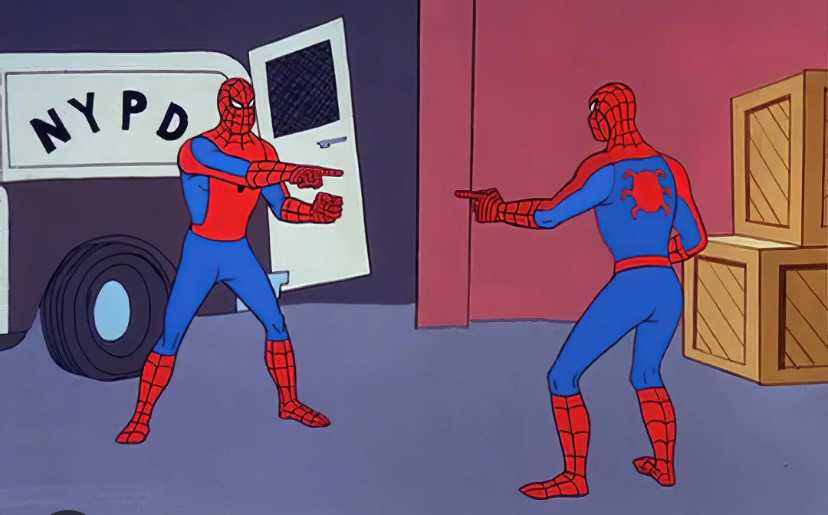-
Posts
11852 -
Joined
-
Last visited
-
Days Won
26
Content Type
Profiles
Forums
Store
Downloads
Recruiting - 2020
2019-2020 Football Season
Football
Entertainment
Sports
News and Business
Cloak Room
Transfer Portal
Recruiting
Events
Everything posted by 956 Worldwide
-

Government Shutdown 2025: This Time It’s Personal
956 Worldwide replied to Bozo_Casanova's topic in Cloak Room
Slowly then all at once. -
Just a live action Little Mermaid reboot and the same reaction to the lead character casting change.
-
What if I told you that Mamdani was just a DeBlasio reboot with some updated SFX and a modern diverse cast?
-
I ran some probabilities for the final stretch through the ESPN predictor. I don’t love FPI but it’s the easiest place to see the different probabilities per game. I didn’t calculate all permutations. Just the more likely, which as you can see— “more likely” is a relative term. Most likely UT scenario: 1L (UGA), 28% UT undefeated or 1L (A&M) are at 20 and 21% UT 2L (UGA, A&M): 21% Most likely for Ole Miss is undefeated, 55% Most likely for Alabama is undefeated, 46% Most likely for UGA is undefeated, 38 % UGA 1L (UT), 26% UGA 1L (MSU), 10% Georgia 2L (UT, MSU) 7% A&M undefeated, 1L, or 2L are all between 20-21%
-

Bleach Blonde Bad Built Butch Body in Congress? Oh you mean Marjorie!
956 Worldwide replied to Pancho's topic in Cloak Room
This is the best sub-plot of 2025. After taking passenger rail to NYC to go on The View to stump for affordable healthcare; MTG takes time to honor the remarkable legacy of former Speaker Pelosi. Despite political differences, Pelosi was an effective leader and inspiring woman who worked to make America better. She is running for the 1996 GOP presidential nomination. The secret shapeshifting cabal accidentally removed the Y2K patch when they sent out an operating system update. -
Updates for 2025: Tex convinced Tammy to form a polycule with Bette after intense discussions of the power dynamics at play. Tammy wants to bring in Corey formally, previously they have only played after meeting him at the medicinal insecticide dispenser. Fiona is trying to pay tuition via OnlyAnts. Paw-Paw is a subscriber, and also sends SS money to AI enabled sex chatbots. Édouard runs a Michelen-starred haute fusion barbecue food truck. Joe Bob is lieutenant governor and working to ban the teaching of non-American languages.
-
YMMV. In highly inflected languages (Slavic and I assume Latin to some degree), correctly gendering nouns will impact not only the noun, but also possible the conjugation of the verb, AND the correct declension of the nouns including direct and indirect objects. Messing it up means your speech might range from “mildly confusing” to “complete gibberish” to “different meaning.” Fluent speakers will also use gender to stand in for pronouns and even nouns— you can construct a sentence where there are no nouns or pronouns as a subject, the gendered verbs imply them. So comprehension will suffer. Not a direct comparison but the structure of gender/declension/conjugation in inflected languages does the work of word order in English. Imagine completely mixing up the order of subject, verb, direct object, indirect object and producing an understandable thought.
-
New CFP selection idea: at the end of the year feed all the results and analytics into AI and run every permutation of every possible FBS schedule for every team 200,000 times. The 12 teams with the most simulated wins are in. I’m workshopping some ideas where we just eliminate the regular season entirely. Replace the games on TV-with curated AI-video matchups that are representative of the simulations. Drastically cut travel and event costs but still demand lucrative media rights. This is how disrupters think.
-
The champions will be in. It’s written in the rules, the five highest conference champions ranked by CFP get in. I suppose there’s a hypothetical world where a Big Ten or SEC champ falls past two G5 champs in rankings but not this year. When I said the CCG winner gets a boost, I mean in seeding vice non CCG winners who might have equal or one more loss. Should have been clearer on that. The thing about SOS is how heavily it’s hypothetical. “If this 3 loss team with a 10 SOS had the schedule of a 2 loss team with the 17 SOS, the records would be flipped.” No one knows that. Its all just vibes. It didn’t happen. The committee will just see teams with decently similar schedules and different records.
-
A couple of things won’t happen: 1. One conference isn’t getting half the slots. The SEC isn’t going to get six in almost any scenario. At that point you’re leaving out either the second place Big Ten team, a two loss Notre Dame, or a Big XII runner up in favor of a sixth SEC team. 2. Two 11-1 SEC teams aren’t getting bumped for conference mates with worse overall records. MAYBE one if something happened like looking completely overmatched in a loss and another team played lights out in the CCG. The CCG winner will almost certainly get a boost and will be in. The loser, if it takes them to two losses and not 3, and especially if they play well in the CCG. And they will figure out some reason to bump one or maybe two of the remaining SEC teams. The final outcome will be tied heavily to who advances to the CCG and the winner will get credit (relatively) and the loser (relatively) not get heavily punished. Being a blue blood won’t play a role. The committee last year elevated SMU over a 9-3 Bama with better wins and a tougher slate. Pretty good data point that they aren’t thinking about ratings or prestige. SOS/SOR will be talked about but message boards overindex this stuff and tend to overstate perceived differences in the extreme. The committee might forgive an extra loss for a team if the difference in SOS is something like 25 or 30 spots. If it’s two SEC teams with SOS at like 10 and 15, they take the better record absent something like a really bad H2H loss. SOS/SOR aren’t scientific and a gap of 5-10 spots contains a lot of noise and subjectivity. The last thing is that while “good” OOC losses might not be punished, that doesn’t mean they will be credited as a good win or even a regular win. Two very different things. At best the loss is memory holed.
-

ChatGPT AI Tool— We all work for robots now
956 Worldwide replied to 956 Worldwide's topic in Daily Texan
I’ve been thinking a lot about now tech tends to flatten material class divides while hardening and intensifying intangible ones. Riding public transportation is instructive. Look and see who is reading a book, who is sitting and thinking, who is emailing for work, who is checking scores or news, who has a podcast or music. All activities either actively enriching or at worst a harmless diversion. Then look at who’s watching TikToks endlessly on full volume or jacked into a stream, who is having meandering and endless phone conversations that have no beginning and no end and no subject. It would be better for them to sit in silence: at least you aren’t actively rotting and rewiring your brain and precluding even the possibility of having an unfiltered and non-narrated observation of reality. In the real Brave New World, the global controllers don’t need to decant alcohol into the Gammas’ artificial embryonic fluid. The Gammas will do it to themselves and their children. Second, it’s been said that sufficiently advanced tech is indistinguishable from magic. It will be a tremendous privilege to understand that it isn’t, and to have a grasp of its limits and correct uses. A new class of priest-astrologers, no different in practice than manipulating knowledge of eclipses and celestial signs into control and pacification of the ignorant masses. I’m less excited about the opportunities for fraud. I think it’s more likely that an exhausted and shrinking techno-priest caste finds themselves forced to use what passes as magic to prevent the masses from destroying themselves and the planet, like in The Marching Morons. I also think a lot of historical religion was closer to that than it was to a pyramid scheme aimed at exploiting the bottom. -

ChatGPT AI Tool— We all work for robots now
956 Worldwide replied to 956 Worldwide's topic in Daily Texan
One thing that’s coming is that young kids who aren’t using AI at are gonna hit the AI kids like introduced predators on an isolated island. Gen Alpha already mocks and notices the degraded capacity of “iPad kids” who got early and frequent screen time. It just amplifies pre-existing, strongly class-based gaps in intellectual development. The kids who don’t get AI will be almost a different species. And there’s no downside because its not like a fucking violin you need to learn early; a critical and original thinker will be able to pick it up later and use it to run laps around the sloppers who are going to grow up with it. -

CFB Week 11 Preview: MACtion, Memphis, But No Tortilla Tossing.
956 Worldwide replied to texifornia's topic in Football
If you are at all interested in FCS football: this is the first year the Ivies will participate in the FCS postseason. I don’t expect them to challenge the elite of the Big Sky or Missouri Valley conferences, but the top tier of the Ivy League plays good football and can have a fun run. -

Nancy Mace: Sexual assault survivor or cuckoo for Cocoa Puffs?
956 Worldwide replied to C-Man's topic in Cloak Room
Correct, it is video of her doing the thing she got detained for. Really love how everyone is mentally ill now. -

UPS Airlines crash on take off at Louisville Airport.
956 Worldwide replied to Laxtonto's topic in Daily Texan
Not as much as you might think when you get up close. It’s awesome, very analog airplane, steampunk vibes. Lots of hot young Athenian babes in togas on that ship…… -
No, I’m not. You’re disliking the math. A better way to look at this: its T+2. Do you want the worst case to be grabbing the 4th SEC slot or the 5th one? Because if Georgia loses and then you beat them, you can lose to A&M and you are still no worse than 4th in based on H2H. If Georgia wins, and you beat them but lose to A&M, then you are hoping that the committee elevates you at 9-3 over a 10-2 UGA. I am assuming the favorites win. That’s not going to happen, but that doesn’t mean it’s smart to bet against it happening in any given contest. I cannot emphasize enough that you want to pass teams that are currently in front of you in any way you can. You can do that by having UGA lose games. The committee ranks teams, not conferences.
-
No, you want Georgia to lose. Georgia is ahead of you in the rankings, and you will play them. You have a path to eliminate a competitor. If they have another loss, you can knock them out from contention by winning. There are more paths available to you if they lose and that outweighs the bonus points you get if they are ranked above you if they win. You would get a quality win regardless and you’d pull ahead in a tiebreaker if you both end up 9-3. If they lose and then beat you, then it’s no difference than if they win and beat you: they will be considered before you for the CFP. Always look for the scenario that gives you the most pathways ahead. And don’t overvalue the “best possible” scenario (beating a highly ranked Georgia). That doesn’t outweigh the upside of just knocking them out of contention for a spot you want. This discussion is real time evidence for never gambling on sports if you have a rooting interest.
-
Virginia is by far the best barometer to look at from the places that voted. My sole hesitation is how you measure the effect of mass layoffs, contractor job losses, and overall anger in the NCR and project that out to states less affected by federal government actions. Likely same trend but not as stark. I think it’s pretty axiomatic that Trump overperforms when he’s on the ballot and GOP underperforms when he’s not. Bodes well for 2028. They admitted as much with the gereymandering ploy.
-
Anastasis getting upset because a poster came in with inscrutable, vaguely accusatory personal questions orthogonal to the discussions at hand.
- 763 replies
-
- 15
-

-

-

-

UPS Airlines crash on take off at Louisville Airport.
956 Worldwide replied to Laxtonto's topic in Daily Texan
25 years is pretty much the average for a cargo plane. Passenger airlines will offload before to a cargo company or overseas budget carrier not because the airplane isn’t safe— just that the needed maintenance, plus cabin overhaul to meet passenger standards, plus savings on more efficient newer models means that hanging on isn’t worth it. @Bobby_Batronic explained a lot about the stressors on critical components and the long life of turbines due to design. Airplanes don’t age like cars, the prescribed obsessive maintenance and the scheduled complete tear-down/rebuilds mean that for the most part you can safely fly an airplane for as long as you want to throw money at it. The USAF intends to keep B-52s in service for about a century of use. (Also a plane that flys lots of long hours as opposed to quick hops). The key here is “if the maintenance is done and money thrown at it.” Usually you can trust major carriers and developed countries to do that. -
I think the lesson not to schedule a good OOC opponent isn’t really reflecting in the committee’s work. That could change with 9 SEC games. Bama is the highest ranked one loss team, and they have arguably the worst loss. But their run against good opponents got rewarded. The committee explained as much. The committee was more than willing to put three two loss teams above multiple one loss teams. They aren’t harshly punishing ND or Texas or Bama for those early season losses. They rewarded the H2H vs OU. The deciding factor was likely the Florida-Kentucky-Miss State games vs Notre Dame. And on the flip side, winning those good early games brings rewards that aren’t being factored into the decision making. On balance, winning probably helps cement your place more than losing dings you. I also think the committee got a lot nerdier on stats that they’d have at their fingertips.
-
Ok. Is the argument that Bama, Ole Miss, and UGA should be replaced with Utah, Georgia Tech, and Louisville?
-

Holy shit you dipshits: 9-3 Texas is probably in the playoffs
956 Worldwide replied to Wulaw Horn's topic in Football
Figuratively and literally. If ND doesn’t ever lose, they are almost always gonna be the national champ. Also true for every team, literally, in the CFP era. -

Government Shutdown 2025: This Time It’s Personal
956 Worldwide replied to Bozo_Casanova's topic in Cloak Room
Accurate, that is the post I clarified. Most of us on this forum have discussions, ask questions, clarify, and maybe find a meme or two. I realize that is less engaging than lurking at the bar long after colleagues have left the happy hour to look for openings to threadshit. You won your one person game, good job. -
The thing that needs ryto to be taken into account is that SEC and BIG teams this year aren’t playing for top 12. They’re playing for top 10.
Football ... Basketball ... Baseball ... Other Sports ... Futbol ... 🤫995🤫 ... Gambling ... Movies & TV ... Music ... Hobbies ... Lulz ... Food & Travel ... Daily Texan ... Business and Markets ... Cloak Room ... Help ... For Sale ... Board Discussion ... Subscribe!... Donate!... COOKIE MONSTER!




